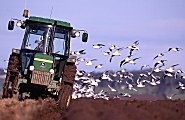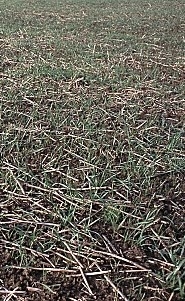 Ploughing is costly in labour, time, energy and machinery. It reduces the soil fauna, exacerbates soil erosion and causes nutrient leaching. Thus adopting an improved cultivation system is at the heart of ICM.
Ploughing is costly in labour, time, energy and machinery. It reduces the soil fauna, exacerbates soil erosion and causes nutrient leaching. Thus adopting an improved cultivation system is at the heart of ICM.
One new type of cultivation is conservation tillage or non-inversion tillage. This is a combination of very shallow cultivation and mulching. This helps to concentrate organic matter in the upper soil layers. It improves soil structure and workability, decreases erosion and leaching, improves drought tolerance and also creates favourable conditions for beneficial predatory invertebrates, micro organisms and earthworms. Weed control is accomplished by good crop rotation and targeted herbicides.
 Non-inversion tillage can be used everywhere. On heavy land, where grass weeds are plentiful, or on sandy soils, where compaction can occur, ploughing may be essential - at least at some stage in the rotation.
Non-inversion tillage can be used everywhere. On heavy land, where grass weeds are plentiful, or on sandy soils, where compaction can occur, ploughing may be essential - at least at some stage in the rotation.
Nevertheless adopting a soil cultivation system that improves soil structure has many advantages. There is reduced runoff of sediment, pesticide and fertiliser. Less cultivation means less energy consumption, lower carbon dioxide emission and increased carbon sequestration because of more soil organic matter. A richer soil biota improves nutrient recycling and may help combat crop pests and diseases. Non-inversion tillage also leaves seeds and crop litter on the surface as food for wildlife.
Ploughing is costly in labour, time, energy and machinery. It reduces the soil fauna, exacerbates soil erosion and causes nutrient leaching. Thus adopting an improved cultivation system is at the heart of ICM.